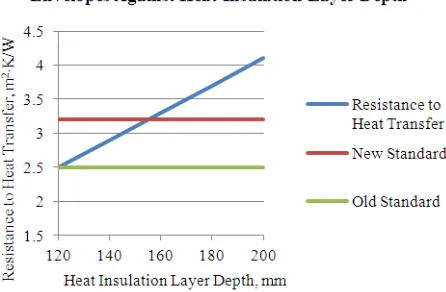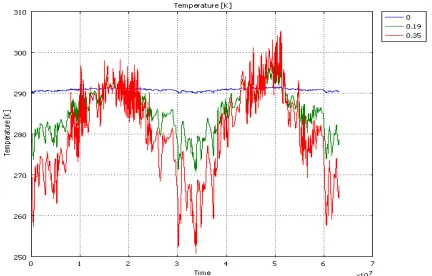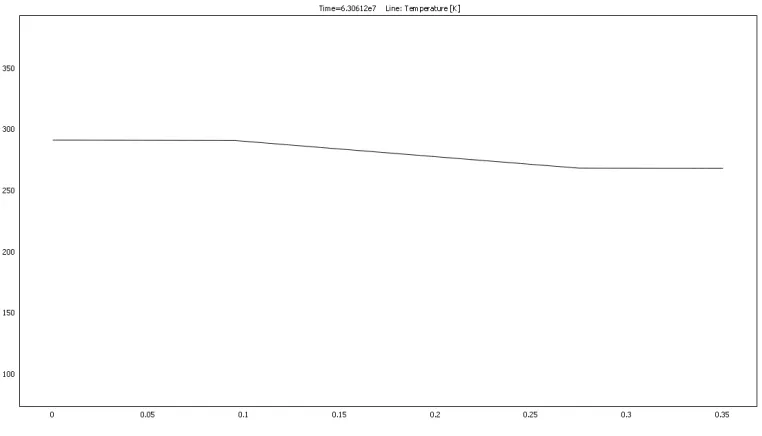International Journal of Energy and Power Engineering
2013; 2(3): 97-103Published online June 20, 2013 (http://www.sciencepublishinggroup.com/j/ijepe) doi: 10.11648/j.ijepe.20130203.12
Modelling and forecasting of one-dimensional
nonstationary heat transfer in building envelopes for
energy efficiency building
Semjen Kundas, Elena Kresova
International Sakharov Environmental University, ISEU, Minsk, Belarus
Email address:
kundas@iseu.by(S. Kundas), elena-kresova@mail.ru(E. Kresova)
To cite this article:
Semjen Kundas, Elena Kresova. Modelling and Forecasting of One-dimensional Nonstationary Heat Transfer in Building Envelopes for Energy Efficiency Building. International Journal of Energy and Power Engineering. Vol. 2, No. 3, 2013, pp. 97-103.
doi: 10.11648/j.ijepe.20130203.12
Abstract:
One-dimensional nonstationary heat transfer in three-layered building envelope is examined in this work. Therefore, initial and boundary conditions are examined. Possibility not only for modelling but for forecasting of heat transfer in capillary-porous structures of building envelopes is considered as well. For this purpose, time series analysis method was used. Standards for resistance of heat transfer in European countries and in Belarus are considered. Resistance to heat transfer of three-layer envelope where internal and exterior layers are precast layers and heat insulation is cellular polystyrene against heat insulation layer depth is examined as well.Keywords:
Heat Transfer, Envelope, Temperature Variation, Heat Insulation, Layer Depth1. Introduction
Effectiveness increase of building envelopes heat insulation task is actual because of energy cost increase and problems with fuel and energy resources.
Energy efficient building of dwelling houses is one of the most important areas of development concept of building complex in Belarus pending 2011-2020 years. Energy efficient building volume is planned to lead up to 6 million m2, and it will compose about 60 % of total area of new building. Rate of heat energy use on heating of these buildings don’t have to exceed 60 kW·h on 1 m2 per year and in perspective to 2020 year don’t have to exceed 30–40 kW·h on 1 m2 per year. This is one of ways to optimize fuel and economy balance of country because Republic of Belarus consumes about 35 %–40 % of energy resources on heating and hot water supply of housing stock.
2. National Energy Efficiency Program
for 2011 - 2015 Years
Long-term goal of activity in field of energy saving for a period to 2015 is energy intensity reduction of GDP of the Republic of Belarus on 50 percent to the level of 2005 year and increment of local supply-demand resources in balance
of boiler-furnace fuel to 28 percent subject to ecological requirements, social standards and provision of energy safety indicators.
As a result of implementation of the national energy efficiency program for 2011 - 2015 years (1) specific heat consumption for heating and ventilation no more than 60 kW·h on 1 m2 per year after rebuilding and building reconstruction will be achieved; (2) building at least 60 percent of energy-efficient houses to 2015 year with specific heat consumption for heating and ventilation no more than 60 kW·h on 1 m2 per year for multistory buildings (from 4 to 9 floors) and no more than 90 kW·h on 1 m2 per year for low-rise buildings (from 1 to 3 floors) of volume construction will be achieved.
emissions; (4) achievement to 2015 year
percent of energy-efficient houses to 2015 year with specific heat consumption for heating and ventilation
60 kW·h on 1 m2 per year for multistory building to 9 floors) and no more than 90 kW·h on 1 m
low-rise buildings (from 1 to 3 floors) of volume construction; (5) design and implementation of
heat utilization of sewage in apartment [1, 2].
2. Mathematical and Physical Model of
One-dimensional Nonstationary Heat
Transfer
2.1. Different Models to Transport Heat
Strict requirements are determined for energy consumption decrease in housing sector. First of all, it realizes thanks to heat-resistance
coefficient increase. One of the most effective optimization methods of this important parameter is application computer modelling and forecasting of heat and humidity conditions of envelopes pending industrial process and operational process methods. It is impossible to solve this task with no account taken of environmental parameters. Particularly it is necessary to have information about air temperature and relative humidity variations in building constructions operational process. In this work possibility of modelling and forecasting of heat transfer using software COMSOL Multiphysics will be examined.
In building heat transfer, many different types of energy transport are effective. Often, heat is transported by different modes to or from the same place. Energy that re
via different paths and modes may be added up for the heat balance [3].
Primary heat transport modes are: (1) c
flow on a molecular scale. Medium at rest or moving), (2) convection (heat conveyed as internal thermal energy of mass that is displaced by mean or turbulent motion) and (3) radiation (heat transfer by electromagnetic waves such as infrared or visible light). One can see these mo
Figure 1. Primary heat transport models
In buildings, heat is also transported by the following mechanisms, which basically belong to the convective to 2015 year building at least 60 s to 2015 year with specific heat consumption for heating and ventilation no more than multistory buildings (from 4 kW·h on 1 m2 per year for s (from 1 to 3 floors) of volume (5) design and implementation of devices for and office buildings
sical Model of
dimensional Nonstationary Heat
eat
Strict requirements are determined for energy consumption decrease in housing sector. First of all, it envelope building . One of the most effective optimization methods of this important parameter is application computer modelling and forecasting of heat and humidity conditions of envelopes pending industrial process and operational solve this task with no account taken of environmental parameters. Particularly it is necessary to have information about air temperature and relative humidity variations in building constructions operational process. In this work possibility of modelling and forecasting of heat transfer using software COMSOL
In building heat transfer, many different types of energy transport are effective. Often, heat is transported by different modes to or from the same place. Energy that reaches a point added up for the heat
(1) conduction (heat cale. Medium at rest or moving), (2) onvection (heat conveyed as internal thermal energy of d by mean or turbulent motion) and (3) adiation (heat transfer by electromagnetic waves such as ee these models in Fig. 1.
Primary heat transport models
ported by the following mechanisms, which basically belong to the convective
model: (1) transfer of latent heat by transport of water or water vapour, (2) thermal energy associated with the air replaced in a building by ventilation or
(infiltration), (3) thermal energy associated with fresh and used domestic water and combustion air (including f gases), and fluids feeding heat p
The transport of energy in the above list is limited to energy in the form of sensible or latent heat. A c
sensible heat is characterized by a variation of temperature while a change of latent heat is associated with some mass altering its phase. Phases are gaseous, liquid, solid. Transport of energy in forms other than heat are not considered.
Heat transfer in buildings may involve the listed types of transport. For an energy balance, other forms of energy often referred to as energy sources or heat loads dynamic (time-dependent) storage of heat in solid, liquid, or gaseous media have to be taken into
2.2. Three-layered Exterior W
Three-layered exterior walls systems of stones, blocks and precast panels with heat insulation as centre are used for different buildings in new construction and reconstruction. They can correspond to bearing structure, non
structure or self-bearing envelope.
Constructively systems are divided into next types: (1) three-layered walls with cladding of stones and blocks and (2) walls of three-layered precast panels.
Examine walls of three-layered precast panels. System is erected of shop-mount panels. Three
construction composed of internal and exterior precast layers and heat insulation located between them.
Internal and exterior precast layers are bearing s
They receive all load and influences impacted on panel. They are made from armoured high
concrete.
Mineral cotton slabs, or staple glass fiber slabs, or cellular polystyrene slabs are used as heat insulation. They set between internal and exterior precast layers and heat insulation is concreted on end surfaces of panels. Heat insulation slabs have to have specified compressibility and moisture for support specified
2.3. Initial and Boundary Conditions
Thermal balance of heat entry from sources and loss them through surface of elementary volume for isotropic heterogeneous medium is expressed
thermal conductivity equation [6
ρс
where р – density of the materia capacity for constant volume; = T(x,y,z,t) – temperature; –
ransfer of latent heat by transport of water or hermal energy associated with the air replaced in a building by ventilation or by air leakage hermal energy associated with fresh and used domestic water and combustion air (including flue gases), and fluids feeding heat pumps.
The transport of energy in the above list is limited to energy in the form of sensible or latent heat. A change of sensible heat is characterized by a variation of temperature while a change of latent heat is associated with some mass altering its phase. Phases are gaseous, liquid, solid. Transport of energy in forms other than heat are not
ransfer in buildings may involve the listed types of transport. For an energy balance, other forms of energy – often referred to as energy sources or heat loads – and dependent) storage of heat in solid, liquid, or
ken into account [4].
Exterior Walls Systems
layered exterior walls systems of stones, blocks and precast panels with heat insulation as centre are used for different buildings in new construction and reconstruction. correspond to bearing structure, non-bearing
bearing envelope.
Constructively systems are divided into next types: h cladding of stones and blocks layered precast panels.
layered precast panels. System is mount panels. Three-layered precast panel is construction composed of internal and exterior precast layers and heat insulation located between them.
Internal and exterior precast layers are bearing structures. They receive all load and influences impacted on panel. They are made from armoured high-density and lightweight
Mineral cotton slabs, or staple glass fiber slabs, or cellular polystyrene slabs are used as heat insulation. They set between internal and exterior precast layers and heat insulation is concreted on end surfaces of panels. Heat ve specified compressibility and moisture for support specified geometry [5].
2.3. Initial and Boundary Conditions
Thermal balance of heat entry from sources and loss them through surface of elementary volume for isotropic ous medium is expressed with classic differential
equation [6].
(1)
density of the material (medium); с – heat ; t – time; x,y,z –coordinates; Т
International Journal of Energy and Power Engineering 2013, 2(3): 97-103 99
Figure 2. Precast panel.
Solving one-dimensional problem we take into account that temperature extends equally on envelope surface, i.e.
0 (2)
λ 0, (3)
and changes only in time t and in space (depth x of envelope). Thermal conductivity equation for one-dimensional task is
ρс (4)
Thermal balance equation for every layer with additional conditions on boundaries of material layers can be written:
с ρ for layer 1 с(ρ( ( for layer 2
с*ρ* * + for layer 3
(5)
Where T1 is a center temperature of the first layer
(interior precast layer), T2 is a center temperature of the
second layer (heat insulation), T3 is a center temperature of
the third layer (exterior precast layer).
On boundaries II (junction between first and second layers) and III (junction between second and third layers) boundary conditions of IV kind are defined. They determine equality of heat flux and temperatures:
|II ( |II, |II (|II (6)
( |III * +|III, (|III *|III (7)
On boundary I and IV complex heat exchange occurs. Heat exchange between interior envelope surface and indoor air and also between exterior envelope exchange and outside air occurs by convection. Then through materials
layers heat exchange occurs by thermal conduction [6]. That’s why on boundary I boundary conditions of II kind are defined (specified density of heat flux) written in (8). And on boundary IV boundary conditions of III kind are defined (specified conditions with environment) written in (9):
012 T456 T17 6 |I (8)
089 T:;<6 T== 6 * +|I> (9) where 012,89 – heat transfer coefficient of envelope surface with indoor (in) and outside (out) air which corresponds sum of coefficients of heat transfer by convection 0@ and radiation 0A, i.e. α = 0@+0A , W/(m2*K); (Тin – Тie) – temperature difference between
indoor air and interior surface of the first layer with thermal conductivity and temperature T1 in the center; (Тout –
Тee) – temperature difference between outside air and
exterior surface of the third layer with thermal conductivity
* and temperature T3 in the center.
3. Heat Insulation
3.1. Heat Insulation Market
Heat-insulating materials are widely applicable in modern building. Building of different construction means their isolation and heat insulation. Heat insulation choice is one of the most important questions which have to be considered thoroughly. Every of heat insulation presented at market has its own running ability making it different among others. Belorussian heat insulation marker grows and develops complied their own rules.
Main part of responsibility for heat saving falls on building parts which contacts with environment taking part in heat exchange with it. There are walls, roof and floor. Heat leaves room and cold comes inside immediately through them. Using energy saving materials allows, as well as to minimize heat loss, reduce wall depth and building time, and cheapen cost of building.
There are a lot of different heat insulation materials. The most popular among them are cellular polystyrene, silicate cotton, fibre glass, foamed polyurethane, stone wool, expanded vermiculite, etc.
3.2. Cellular Polystyrene
Cellular polystyrene is produced by method of polystyrene foaming (styrene) and following sintering of foamed grains. In building this heat insulation is used 50 years. It is a light material well glued with other building materials. Advantages of cellular polystyrene are ecological compatibility, nontoxicity, low thermal conductivity (0,030–0,040 W/m·К) and density (15–40 kg/m³). Material is near nonageing.
alkaline medium resistance. It has resistance to paints, alcohols, glues and bitumen as well. Cellular polystyrene strength allows use it as an element of construction surviving heavy loads during long time. Cellular polystyrene doesn’t absorb moisture, doesn’t be exposed to dote and doesn’t create nutrient medium for bacteria and fungi. Useful time is unlimited.
Disadvantages of cellular polystyrene are vapor permeability in consequence of which outgoing from room moisture plugging happens and high work content. Owing to moisture plugging, microclimate changes in room. As a result wall efflorescence can be.
Cellular polystyrene is combustible material. That’s why it is necessary to fulfill requirements of fire safety
As heat insulation cellular polystyrene is used in following constructions: (1) in plastering systems of external heat insulation, (2) in systems with heat insulation interiorly of building envelope, (3) in systems with heat insulation inside of building envelope (three-layered concrete or reinforced concrete panels, etc.), and so on.
3.3. Resistance to Heat Transfer and Heat Insulation Layer Depth
All countries have their own requirements for envelope heat-proofing features changing through time. You can see them in Table 1. Sometimes different values are provided for apartment and public buildings or for buildings with different shape. In addition minimum values for heat-proofing features are determined. They are presented in Table 2. In Italy, Denmark, Slovenia and Germany (for apartment buildings) heat transfer through building envelopes is limited with using average value of heat-proofing features; at the same time in Hungary heat transfer through building envelopes is limited with energy need for heating. In several countries (Italy, Spain, France) values of heat-proofing features vary against climatic conditions determined location including spacing from sea and height above sea level. Finland and Norway use less strict requirement for thermal protection of wood buildings for protection of wood building traditions [7].
Table 1. Desired value of resistance to heat transfer for standardized buildings in several European countries [7]
Country Year of a implementation Type of building Resistance to heat transfer, m2 K/W
France 2005 Apartment 2,78
Belgium 2008 Apartment 2,0
the Netherlands 2011 Apartment 3,45
Germany 2009
Apartment 3,57
Public 3,57/2,86*
Great Britain 2010 Public 5,55
Italy 2010 – 3.03
Hungary 2006 – 2,22
Romania 2006 – 1,41
Denmark 2006 – 5,00
Norway 2007 – 5,56
Sweden 2008 – 5,56
Finland 2010 – 5,58
* For inside air temperature respectively >19 °C/<19 °C ** Threshold value or the hottest climatic zones of Italy
Table 2. Minimum values of resistance to heat transfer in several European countries [7]
Country Year of a implementation Type of building Resistance to heat transfer, m2 K/W
France 2005 – 2,22
Germany 2009
Apartment 2,50-1,54
Public 2,86/2,001*
International Journal of Energy and Power Engineering 2013, 2(3): 97-103 101
Hungary 2006 – 2,22
Romania 2006 – 1,41
Denmark 2006 – 2,5
Norway 2007 – 4,55
Finland 2010 – 1,66
*. For inside air temperature respectively >19 °C/<19 °C
In pursuance of orders of president and government of the Republic of Belarus about energy protection, implementation energy efficient method of design, building and building reconstruction and using domestic energy saving and resources saving element of constructions, materials and energy saving engineering systems and also for complex solving of problem of increase building energy efficiency Ministry of architecture and building changed normative values of resistance to heat transfer of envelopes. New standard of resistance to heat transfer for building envelopes is 3,2 m2° K/W.
In Table 3 you can see how resistance to heat transfer of three-layer envelope where internal and exterior layers are precast layers and heat insulation is cellular polystyrene changes against heat insulation layer depth.
Resistance to heat transfer is calculated by (10) [5]:
B CDE B@ CFGH (10)
where αin – coefficient of heat transfer of envelope
interior, W/(m2⋅°K);
Rc – heat resistance of envelope, m2⋅°K/W;
αн – coefficient of heat transfer of envelope outside for
winter conditions, W/(m2⋅°K)) [5].
Table 3. Resistance to heat transfer and heat insulation layer depth
Heat Insulation layer depth, mm Resistance to heat transfer, m2 K/W
120 2,5
140 2,9
160 3,3
180 3,7
200 4,1
In Fig.3 is shown graph of resistance to heat transfer of three-layered envelope building against heat insulation layer depth. Also on this graph old and new standards of resistance to heat transfer are presented which equal 2,5 и 3,2 m2° K/W respectively.
On presented graph you can see if heat insulation layer increases than resistance to heat transfer of building envelope increases, too. At the same time it is necessary to take into account that price of construction increases as well. If to consider that to 2020 year specific fuel consumption will go down to 30–40 kW·h on 1 m2 per year therefore it will determine new standards for resistance to heat transfer
for building envelopes. That’s why it will be necessary to apply new constructive, technological engineering decisions and engineering devices to reduce price of construction, to increase resistance to heat transfer and reduce depth of envelope.
Figure 3. Resistance to heat transfer
4. Result and Discussion
Simulate heat transfer in three-layered envelope using software COMSOL Multiphysics where interior and exterior layers are precast panels and heat insulation is cellular polystyrene. Data are shown in Table 4. On boundary I constant temperature was defined as 18˚С and on boundary IV outside temperature was defined as air temperature variation in Minsk for two years.
In Fig. 4 temperature variation on boundary I (blue curve), in the middle of the second layer (green curve) and on boundary IV (red curve) are displayed. And in Fig. 5 temperature variation in profile of multilayer envelope is shown [8].
Figure 4. Temperature variation on different depth simulating of real data.
For model verification of predicted values coefficient of determination and standard deviation were used [9]. Coefficient of determination ranges from 0 to 1. The closer coefficient of determination is to 1 the better model describes initial data. It was determined that coefficient of determination equals 0,79, so one can say that target model rather well describes original time series because time series has a lot of observations. Standard deviation is 4,92˚С [10].
Then we put predicted values in return for real data. From Fig. 6 is it possible to see how temperature changes on boundary I (blue curve), in the middle of the second layer (green curve) and on boundary IV (red curve). compared with temperature variation values of three-layered envelope simulating of real data. Verification showed that model of temperature variation of three-layered envelope simulating of additive time series model describes of high coefficient of determination.
Thereafter obtained temperature variation data of three-layered envelope simulating of predicted data were.
5. Conclusions
Nonstationary one-dimensional heat transfer in three-layered envelope buildings with interior and exterior layers from precast panels and heat insulation from cellular polystyrene was examined in this work. Initial and boundary conditions for this way were examined as well.
Figure 6. Temperature variation simulating of predicted values
Resistance to heat transfer in several European countries are considered. Resistance to heat transfer of three-layer envelope where internal and exterior layers are precast layers and heat insulation is cellular polystyrene against heat insulation layer depth is examined.
In this study different models of time series which describes air temperature variation in Minsk were considered. Obtained additive model describes original time series with satisfactory precision for practical using and provides air temperature prediction with satisfactory precision for practical application: high coefficient of determination and low standard deviation. Obtained additive time series model allows forecast of heat transfer in capillary-porous structures of building constructions.
Table 4. Parameters of three-layered envelope
Parameters Layer 1 Layer 2 Layer 3
Material reinforced concrete cellular polystyrene reinforced concrete
Depth d in m 0.095 0.180 0.075
Density ρ in kg/m3 2500 25 2500
Heat capacity cp in J/(kg*K) 840 1340 840
International Journal of Energy and Power Engineering 2013, 2(3): 97-103 103
Figure 5. Temperature profile
Acknowledgements
This study was carried out in the frame of grant of Ministry of Education of Belarus. We also wish to thank Mr. A. Polishjuk, director of State Institution «National Meteorology Centre», for given air temperature data, and Dr. Gishkeluk, for his consultations and advice.
References
[1] The national energy efficiency program for 2011 - 2015 years.
[2] Crosscutting agenda for design, building and reconstruction of power efficient apartment buildings in Belarus for 2009–2010 years and prospect to 2020 year.
[3] J. A. Clarke. Energy Simulation in Building Design. Adam Hilger Ltd., Bristol and Boston, 1985.
[4] H. Hens, editor (1995) Heat, Air and Moisture Transfer in Insulated Envelope Parts, several volumes. International Energy Agency, IEA, Energy Conservation in Buildings and Community Systems (BCS), Annex 24.
[5] Technical code of Belarus 45-2.04-43-2006(02250). Building heat engineering. Building design standard.
[6] S. P. Kundas, I. A. Gishkeluk, V. I. Kovalenko, O. S. Hilko. Computer modelling of contaminant migration in natural disperse media. Minsk, ISEU Press, 2011.
[7] О. Seppanen. Requirements for building energy efficiency in EU countries, Energy saving, №7/2010.
[8] S. Kundas and E. Kresova. Forecasting of air temperature variation in heat transfer tasks of capillary-porous structures. In Proceedings of the First Virtual International Conference, Advanced Research in Scientific Areas, Slovak Republic, 2012.
[9] M.D. Dettinger, M.Ghil, C.M.Strong, W.Weibel, and P.Yiou, Software expedites singular-spectrum analysis of noisy time series, Eos Trains. AGU, 76(2), 12, 1995.
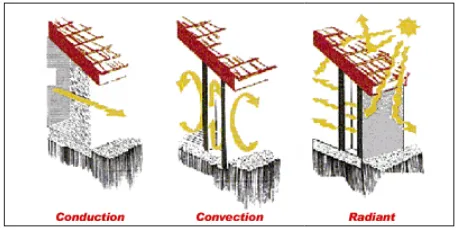
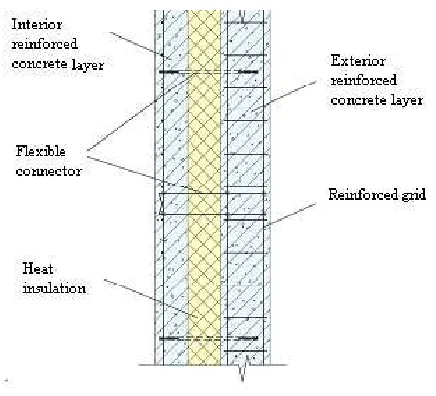
![Table 1. Desired value of resistance to heat transfer for standardized buildings in several European countries [7]](https://thumb-us.123doks.com/thumbv2/123dok_us/8487997.1715739/4.595.62.549.374.615/table-desired-resistance-transfer-standardized-buildings-european-countries.webp)
